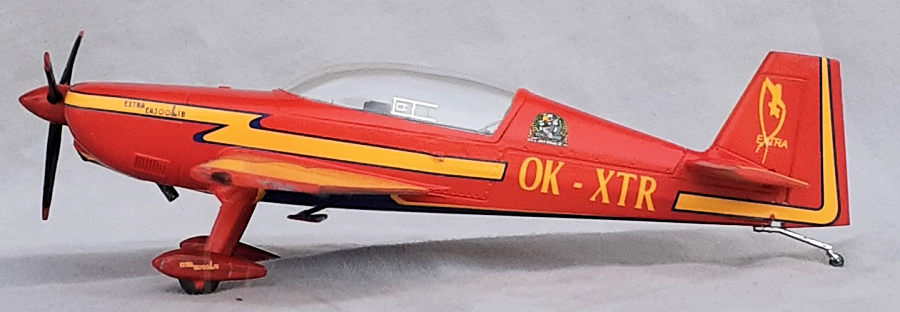
Brengun 1/48 Extra EA300L
| KIT #: | 48007 |
| PRICE: | $52.00 |
| DECALS: | Two options |
| REVIEWER: | John Summerford |
| NOTES: | Photo etch is $22.00 extra |

| HISTORY |
The Extra Flugzeugbau EA-300 is a two-seat aerobatic
monoplane capable of Unlimited category competition. It was designed in 1987 by
Walter Extra, an award-winning German aerobatic pilot and built by Extra
Flugzeugbau. Design of the Extra EA-300 was based on the Extra EA-230, an early
1980's monoplane having a wing made of wood. The Extra EA-300 has a welded steel
tube fuselage covered in aluminum and fabric. T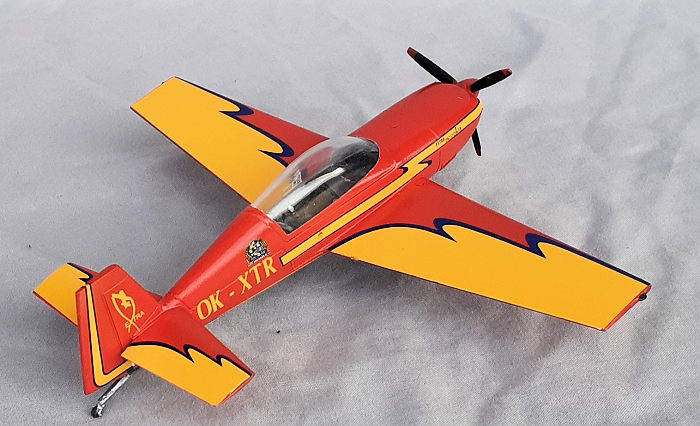 he mid-set wing has a carbon
fiber composite spar and carbon composite skins. A symmetrical airfoil, mounted
with a zero angle of incidence, provides equal performance in both upright and
inverted flight. The landing gear is fixed taildragger style with composite main
legs and fiberglass wheel pants. The powerplant is a fuel-injected Lycoming
AEIO-540 which produces 300 hp (224 kW).
he mid-set wing has a carbon
fiber composite spar and carbon composite skins. A symmetrical airfoil, mounted
with a zero angle of incidence, provides equal performance in both upright and
inverted flight. The landing gear is fixed taildragger style with composite main
legs and fiberglass wheel pants. The powerplant is a fuel-injected Lycoming
AEIO-540 which produces 300 hp (224 kW).
The first two-seat Extra EA-300 made its maiden flight on 6 May 1988, with German type certification following on 16 May 1990. The single seat Extra EA-300S flew on 4 March 1992.
The Extra EA-300 is stressed for ±10“g” with one person on board and ±8Ig with two. Some Extra EA-300's are certificated in the Experimental Category in the U.S., while others are certificated in the Aerobatic category.
Extra EA-300L is also a two-seat version with low mounted wing and shorter fuselage. More Extra EA-300L aircraft have been produced than any other model. Its wing is mounted at the bottom of the fuselage, with its span reduced from 26 ft 3 in (8.00 m) to 24 ft 3 in (7.39 m). Improved ailerons boost the EA-300L's roll rate to 400 degrees per second. All EA-300L's are fully certified under FAA and European Joint Aviation Authorities regulations.
| THE KIT |
Unlike most of Brengun’s products, this is an injection molded kit. It comes in an end-opening box and consists of two sprues of blueish-gray crisply molded sprues that look similar to Airfix’s offerings. The backside of the box has color information. Sidewall detail is molded into the fuselage halves. Overall detail might be a bit overstated, but with a flashy paint scheme, that may not be an issue. A four bladed prop is included, but not for use with this airframe.
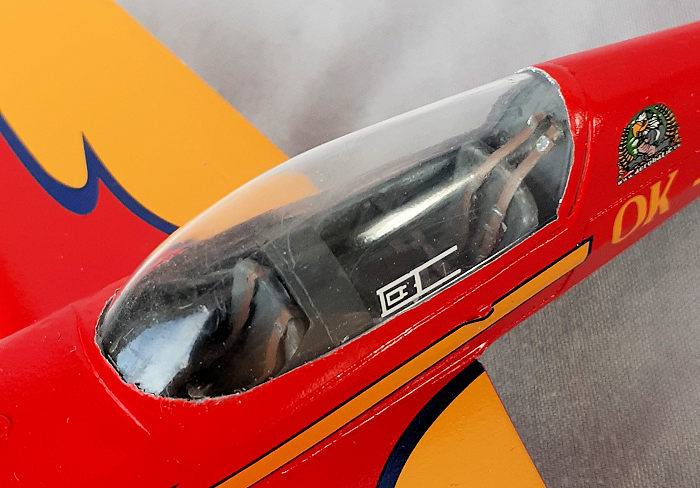 The instructions are on a bi-fold sheet and includes a
parts map. The only text is generic color call-outs in Czech and English.
Assembly starts with subassemblies for the cockpit, prop, and wheels. The
cockpit gets trapped in the fuselage halves, followed by attaching the wings and
stabs. Underside details come next and the canopy is added last.
The instructions are on a bi-fold sheet and includes a
parts map. The only text is generic color call-outs in Czech and English.
Assembly starts with subassemblies for the cockpit, prop, and wheels. The
cockpit gets trapped in the fuselage halves, followed by attaching the wings and
stabs. Underside details come next and the canopy is added last.
To model an acrobatic aircraft, one can either scratch build the reference rods for the wing tips, (clearly in view in the cover photo) or buy the photo-etch fret. The fret also includes an instrument panel with acetate dials, seat belts, and a few other details.
Decals are provided for two aircraft. Trim lines and ID lettering are provided for an English plane painted black and yellow that the modeler will have to reproduce. The aircraft seen on the cover is a red Spanish plane with yellow and blue markings and is the second option. Those markings are provided as decals.
| CONSTRUCTION |
A coat of primer was sprayed over the interior parts, and the photo-etch fret. Detail painting was done before any parts were glued together. The cockpit assembly was routine except for the rear bulkhead part. It does not have any tabs or gussets to align it properly to the floor. That was discovered when installing the floor/seat subassembly to the right fuselage half. After removing material with a saw blade at the back side of the join, the correct angel was achieved.
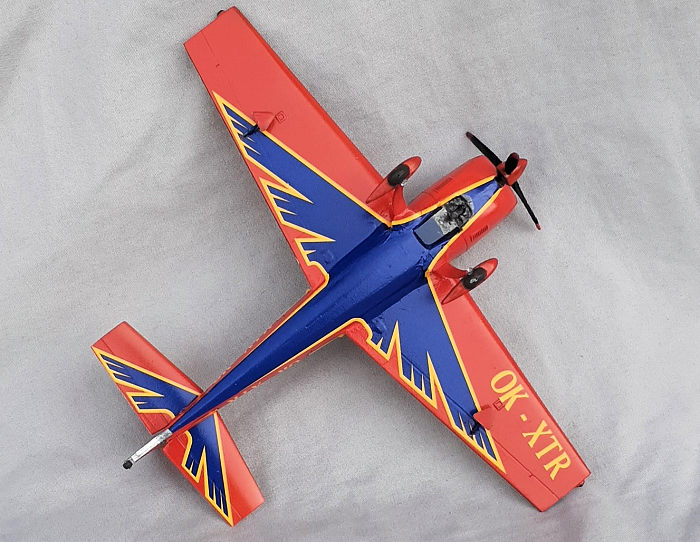 Before completing the cockpit after the fuselage
halves were mated, the seam was addressed. After that, the instrument panel and
frame bracers were installed.
Before completing the cockpit after the fuselage
halves were mated, the seam was addressed. After that, the instrument panel and
frame bracers were installed.
Alignment tabs are molded into the wings and stabilizers and worked well enough to leave small seams to fill, however, it is unclear if a small amount of dihedral should be induced.
To get a good fit with the canopy, about a millimeter was removed from the rear edge. The front edge stood proud of the nose and, after masking, was carefully scraped and sanded flush.
Perhaps the most amount of work was done filling and sanding the exhaust area of the cowl and the landing gear. A couple of sessions were spent on those parts. When everything looked good, it was time for painting.
| COLORS & MARKINGS |
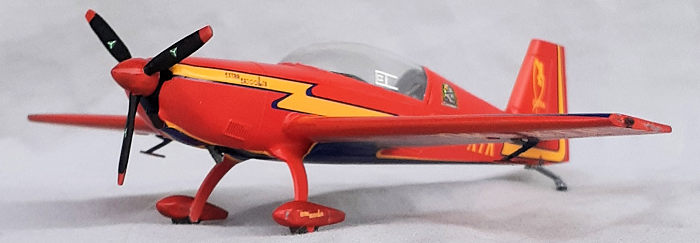 Alclad Clear Base was sprayed over the canopy frame
followed by a coat of Dark Ghost Gray. As seems usual for me, the first coat of
primer that was applied to the rest of the model revealed that the seams,
particularly around the landing gear fairings, needed much more work. After the
second primer coat, Insignia Red from MRP was used as the base color and a gloss
coat applied.
Alclad Clear Base was sprayed over the canopy frame
followed by a coat of Dark Ghost Gray. As seems usual for me, the first coat of
primer that was applied to the rest of the model revealed that the seams,
particularly around the landing gear fairings, needed much more work. After the
second primer coat, Insignia Red from MRP was used as the base color and a gloss
coat applied.
Four sessions of decaling followed. Thankfully, the colors are opaque and they handled fairly well. The most difficult areas were the fairings around the main legs and at the nose. Some slicing with a razor blade then touch-up paint was brushed around the fairings and Solv-A-Set took care of the nose. None of the decals needed any trimming.
When the decals had settled down, another gloss coat was sprayed over them.
| FINAL CONSTRUCTION |
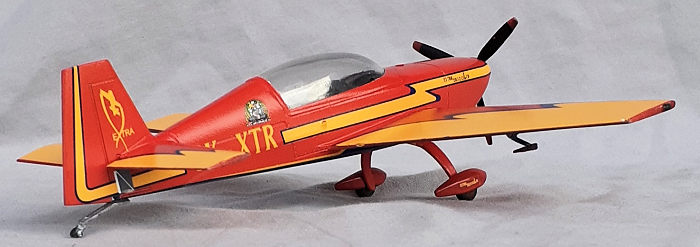 I often think of the Twilight Zone episode of a
woman’s head having the bandages removed after plastic surgery as I unmasked the
canopy. Unlike the story, my result was successful. Being as the rest of the
parts are delicate, progress was slow so that the glue could cure on one piece
before moving on to the next.
I often think of the Twilight Zone episode of a
woman’s head having the bandages removed after plastic surgery as I unmasked the
canopy. Unlike the story, my result was successful. Being as the rest of the
parts are delicate, progress was slow so that the glue could cure on one piece
before moving on to the next.
The tail wheel was added, then the main wheels. There is a set of servo plates for the ailerons in the photo-etch fret. My hat is off to you if you can attach them permanently without large blobs of cyano. I didn’t even try. Instead, I thinned the styrene pieces and used liquid cement.
I did try to install the reference rods at the wingtips. Unfortunately, they proved to be too fiddly for me, so I omitted them and completed the build by installing the prop.
| CONCLUSIONS |
This build was all about the decals. The airframe is just the foundation for their application.
Despite being a short-run kit, there was not much extra work compared to long-run kits. Some of the parts are misnumbered, so pay attention to the illustrations and parts map. The photo etch parts are worth using. The low parts count and conventional assembly sequence made for a relatively easy build. It is a good kit for a modeler’s first try of the type. In some ways it is much like a resin build, so the kit is also good for one to make a transition to that medium.
John Summerford
24 June 2024 Copyright ModelingMadness.com. All rights reserved. No
reproduction in part or in whole without express permssion from the editor.
If you would like your product reviewed fairly and fairly quickly, please
contact
the editor or see other details in the
Note to
Contributors.